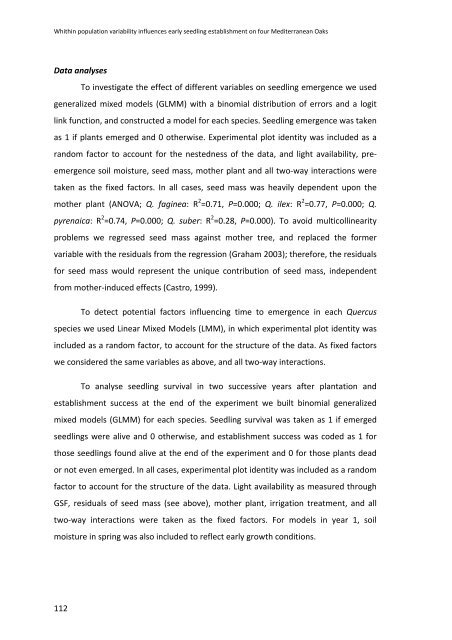Establecimiento de cuatro especies de Quercus en el sur de la ...
Establecimiento de cuatro especies de Quercus en el sur de la ...
Establecimiento de cuatro especies de Quercus en el sur de la ...
You also want an ePaper? Increase the reach of your titles
YUMPU automatically turns print PDFs into web optimized ePapers that Google loves.
Whithin popu<strong>la</strong>tion variability influ<strong>en</strong>ces early seedling establishm<strong>en</strong>t on four Mediterranean Oaks<br />
Data analyses<br />
To investigate the effect of differ<strong>en</strong>t variables on seedling emerg<strong>en</strong>ce we used<br />
g<strong>en</strong>eralized mixed mo<strong>de</strong>ls (GLMM) with a binomial distribution of errors and a logit<br />
link function, and constructed a mo<strong>de</strong>l for each species. Seedling emerg<strong>en</strong>ce was tak<strong>en</strong><br />
as 1 if p<strong>la</strong>nts emerged and 0 otherwise. Experim<strong>en</strong>tal plot i<strong>de</strong>ntity was inclu<strong>de</strong>d as a<br />
random factor to account for the nestedness of the data, and light avai<strong>la</strong>bility, preemerg<strong>en</strong>ce<br />
soil moisture, seed mass, mother p<strong>la</strong>nt and all two‐way interactions were<br />
tak<strong>en</strong> as the fixed factors. In all cases, seed mass was heavily <strong>de</strong>p<strong>en</strong><strong>de</strong>nt upon the<br />
mother p<strong>la</strong>nt (ANOVA; Q. faginea: R 2 =0.71, P=0.000; Q. ilex: R 2 =0.77, P=0.000; Q.<br />
pyr<strong>en</strong>aica: R 2 =0.74, P=0.000; Q. suber: R 2 =0.28, P=0.000). To avoid multicollinearity<br />
problems we regressed seed mass against mother tree, and rep<strong>la</strong>ced the former<br />
variable with the residuals from the regression (Graham 2003); therefore, the residuals<br />
for seed mass would repres<strong>en</strong>t the unique contribution of seed mass, in<strong>de</strong>p<strong>en</strong><strong>de</strong>nt<br />
from mother‐induced effects (Castro, 1999).<br />
To <strong>de</strong>tect pot<strong>en</strong>tial factors influ<strong>en</strong>cing time to emerg<strong>en</strong>ce in each <strong>Quercus</strong><br />
species we used Linear Mixed Mo<strong>de</strong>ls (LMM), in which experim<strong>en</strong>tal plot i<strong>de</strong>ntity was<br />
inclu<strong>de</strong>d as a random factor, to account for the structure of the data. As fixed factors<br />
we consi<strong>de</strong>red the same variables as above, and all two‐way interactions.<br />
To analyse seedling <strong>sur</strong>vival in two successive years after p<strong>la</strong>ntation and<br />
establishm<strong>en</strong>t success at the <strong>en</strong>d of the experim<strong>en</strong>t we built binomial g<strong>en</strong>eralized<br />
mixed mo<strong>de</strong>ls (GLMM) for each species. Seedling <strong>sur</strong>vival was tak<strong>en</strong> as 1 if emerged<br />
seedlings were alive and 0 otherwise, and establishm<strong>en</strong>t success was co<strong>de</strong>d as 1 for<br />
those seedlings found alive at the <strong>en</strong>d of the experim<strong>en</strong>t and 0 for those p<strong>la</strong>nts <strong>de</strong>ad<br />
or not ev<strong>en</strong> emerged. In all cases, experim<strong>en</strong>tal plot i<strong>de</strong>ntity was inclu<strong>de</strong>d as a random<br />
factor to account for the structure of the data. Light avai<strong>la</strong>bility as mea<strong>sur</strong>ed through<br />
GSF, residuals of seed mass (see above), mother p<strong>la</strong>nt, irrigation treatm<strong>en</strong>t, and all<br />
two‐way interactions were tak<strong>en</strong> as the fixed factors. For mo<strong>de</strong>ls in year 1, soil<br />
moisture in spring was also inclu<strong>de</strong>d to reflect early growth conditions.<br />
112

















